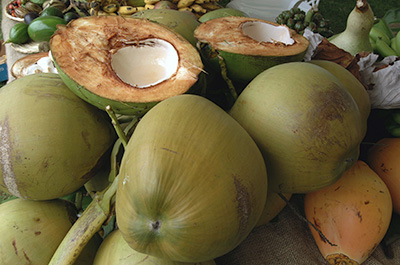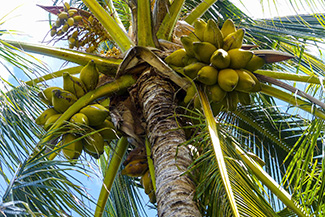Coconut Palm

Coconut palms (Cocos nucifera Linn) are the most ubiquitous symbol of the tropics and distributed throughout the world. In Florida, these palms are located along the east and west coasts.
Coconut palms are not only an important horticulture palm but are also the most economically important palm worldwide. Coconut meat (the white layer on the inside of the coconut) is eaten fresh, dried, and in its immature phase can be eaten with a spoon. Coconut oil is derived from “copra,” a dried form of the meat. The oil is used for cooking, cosmetics, and many other uses. Coir, the fiber from the fruit husk, is used in substrate mixes and can be made into rope.
Characteristics
The UF/IFAS Assessment of Non-Native Plants in Natural Areas has determined that coconut palm is predicted to be invasive in South Florida. Luckily, it can still be planted if the following conditions are satisfied:
- Coconut palm must not be planted near canals (and other flowing waterways) or adjacent to natural areas.
- Fallen fruit must be prevented from entering canals and other flowing waterways connected to open waters (including coastal).
- Unwanted fruit must be placed in yard waste.
In North and Central Florida, the IFAS Assessment deems coconut palm as “not a problem species” and “plant with caution,” respectively. View the full assessment at the IFAS Assessment website.
Coconut palms should only be planted in USDA Hardiness Zones 10B-11 since they are not suitable for freezing temperatures. Coconut requires full sunlight and tolerates both flooding and wind. The ideal time to plant is during the warm and rainy summer months, but they can be planted anytime.

The trunk of coconut palms is smooth and a light grayish-brown color. They can grow to be over 80-100 feet tall. Growth patterns can vary by variety. Some have trunks that are curved or leaning, while others are relatively straight. Their leaves can be up to 18 feet long and a foot wide. Coconut palms begin to flower after four to six years. The flowers are small, yellow, and borne on branchlets that are two to three feet long.
The fruits on coconut palms are over a foot long and a foot wide with a thick, green husk. Under the husk, the fruits contain a nut with a brown, hairy shell that has three sunken holes of softer tissue called “eyes” at the end. Inside the shell at maturity is a white, one-inch-thick layer known as “meat” or copra. It is fully mature when the copra becomes firm. It takes 20 years for coconut palms to reach full production; at that point fruits are produced throughout the year (each fruit taking a year to develop). Annual production is about 50-200 fruits per palm. Harvesting the coconuts can be done with an extended saw pole.
If you are looking for a unique coconut palm, there are several interesting cultivars. ‘Jamaican Tall’, also called ‘Atlantic Tall’, has a crooked trunk and a swollen trunk base. The ‘Malayan Dwarf’ is best if you want a smaller version, as it has a narrow, straight trunk. Other options include ‘Panama Tall’ and the hybrid ‘Maypan’.
Planting and Care

Coconut palms thrive in tropical climates with sandy soils. In temperate regions, it’s best to plant them in the warm, rainy summer months. Transplants should be planted about one inch below the soil’s surface and watered immediately after planting. Apply a few inches of mulch to the surface to help retain moisture and avoid extra weed growth. It is necessary to give them about one inch of water weekly from either rainfall or irrigation during the first year of transplanting.
The brown coconut seeds are ready to be propagated when you hear a “sloshing” sound once shaken. Germination will be best in high temperatures. Place the coconuts on their side and bury them under mulch or sand, leaving one third of the nut above ground. Coconuts can be planted in closely spaced rows or in large pots. Six-month-old palms can be placed directly into the ground.
Coconut is susceptible to nutrient deficiencies. You can correct or prevent this issue by regularly applying a palm-specific fertilizer commonly known as “Palm Special” three to four times per year. Check out this Ask IFAS publication for more information on fertilizing palms, or contact your county Extension office for help.
Diseases and Pests

Photo: USDA Forest Service Region 8 Southern, Bugwood.org
The most efficient way to avoid diseases is to ensure the palms are planted in well-draining locations. Lethal yellowing is the most problematic disease of coconut palms. Signs of lethal yellowing include premature fruit dropping and blackening stalks. Once the leaves turn yellow, the palm will likely die within six months. Lethal bronzing happens in a similar manner, with oldest leaves discoloring first until the disease progresses into the collapse of the spear leaf.
Coconut palms are also susceptible to bud rot. New fronds will turn darker brown until they fall off. Palms showing large amounts of bud rot should be removed and destroyed. Bud rot can be prevented by spraying a phosphorus acid product like fosetyl-Al. As with all horticultural chemicals, follow the product’s label instructions carefully.
Coconut palms are prone to several pests, such as palm aphids, spider mites, and several scales, but occasional pest issues are unlikely to be lethal. Contact your local UF/IFAS Extension agent if you notice severe pest or disease problems on your palms.
With a little patience and care, you can enjoy your new tropical palm and the (eventual) tasty fruits of your labor!
